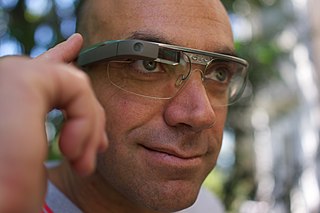
Augmented reality (AR) is an interactive experience that combines the real world and computer-generated 3D content. The content can span multiple sensory modalities, including visual, auditory, haptic, somatosensory and olfactory. AR can be defined as a system that incorporates three basic features: a combination of real and virtual worlds, real-time interaction, and accurate 3D registration of virtual and real objects. The overlaid sensory information can be constructive, or destructive. As such, it is one of the key technologies in the reality-virtuality continuum.

A diving helmet is a rigid head enclosure with a breathing gas supply used in underwater diving. They are worn mainly by professional divers engaged in surface-supplied diving, though some models can be used with scuba equipment. The upper part of the helmet, known colloquially as the hat or bonnet, may be sealed directly to the diver using a neck dam, connected to a diving suit by a lower part, known as a breastplate, or corselet, depending on regional language preferences. or simply rest on the diver's shoulders, with an open bottom, for shallow water use.

Jeri Janet Ellsworth is an American entrepreneur, computer chip designer and inventor. She gained fame in 2004 for creating a complete Commodore 64 emulator system on a chip housed within a joystick, called Commodore 30-in-1 Direct to TV. It runs 30 video games from the 1980s, and at peak, sold over 70,000 units in a single day via the QVC shopping channel.

A virtual retinal display (VRD), also known as a retinal scan display (RSD) or retinal projector (RP), is a display technology that draws a raster display directly onto the retina of the eye.
Vuzix is an American multinational technology company headquartered in Rochester, New York and founded by Paul Travers in 1997. Vuzix is a supplier of wearable virtual reality and augmented reality display technology. Vuzix manufactures and sells computer display devices and software. Vuzix head-mounted displays are marketed towards mobile and immersive augmented reality applications, such as 3D gaming, manufacturing training, and military tactical equipment. On January 5, 2015, Intel acquired 30% of Vuzix's stock for $24.8 million.

Recon Instruments was a Canadian technology company that produced smartglasses and wearable displays marketed by the company as "heads-up displays" for sports. Recon's products delivered live activity metrics, GPS maps, and notifications directly to the user's eye. Recon's first heads-up display offering was released commercially in October 2010, roughly a year and a half before Google introduced Google Glass.
Gamevice, Inc. is a Simi Valley, California based tablet and tablet peripherals manufacturer specializing in gaming products.

An optical head-mounted display (OHMD) is a wearable device that has the capability of reflecting projected images as well as allowing the user to see through it. In some cases, this may qualify as augmented reality (AR) technology. OHMD technology has existed since 1997 in various forms, but despite a number of attempts from industry, has yet to have had major commercial success.

Smartglasses or smart glasses are eye or head-worn wearable computers. Many smartglasses include displays that add information alongside or to what the wearer sees. Alternatively, smartglasses are sometimes defined as glasses that are able to change their optical properties, such as smart sunglasses that are programmed to change tint by electronic means. Alternatively, smartglasses are sometimes defined as glasses that include headphone functionality.

castAR was a Palo Alto–based technology startup company founded in March 2013 by Jeri Ellsworth and Rick Johnson. Its first product was to be the castAR, a pair of augmented reality and virtual reality glasses. castAR was a founding member of the nonprofit Immersive Technology Alliance.

Meta was a company that designed augmented reality products. The company was founded by Meron Gribetz in 2012, based on the "Extramissive spatial imaging digital eye glass" technology invented by Gribetz and Mann originally filed with the US Patent and Trademark office Jan 3, 2013.
LyteShot was an interactive augmented reality gaming platform.

Windows Mixed Reality (WMR) is a discontinued platform by Microsoft which provides augmented reality and virtual reality experiences with compatible head-mounted displays.
DAQRI was an American augmented reality company headquartered in Los Angeles, CA.

Spectacles are smartglasses dedicated to recording video for the Snapchat service. This term is often used to address sunglasses and eyeglasses. They feature a camera lens and are capable of recording short video segments and syncing with a smartphone to upload to the user's online account. They were developed and manufactured by Snap Inc., and announced on September 23, 2016. The smartglasses were released on November 10, 2016. They are made for Snap's image messaging and multimedia platform, Snapchat, and were initially distributed exclusively through Snap's pop-up vending machine, Snapbot. On February 20, 2017, Snap Spectacles became available for purchase online.

A glass breaker is a hand tool designed to break through a window glass in an emergency. It is a common safety device found in vehicles to aid in the emergency extrication of occupants from a vehicle, as well as in some buildings.
Everysight Ltd. is an Israeli technology company established in 2014 as a spinoff of Elbit Systems. Everysight develops smartglasses based on augmented reality technology for the civilian market. The company's main product is Raptor smartglasses.
Ray-Ban Meta is a range of smartglasses created by Meta Platforms and EssilorLuxottica. They include two cameras, open-ear speakers, a microphone, and touchpad built into the frame. They are latest in a line of smartglasses released by major companies including Snap Inc and Google and are designed as one component of Facebook’s plans for a metaverse.
Project Iris is the codename for an unreleased augmented reality (AR) headset designed and developed by Google. It was intended to resemble ordinary eyeglasses and expected to be released in 2024, until its cancellation in early 2023.
Electronic glasses are a form of eyewear that incorporates digital electronics and includes a few different types of devices.











